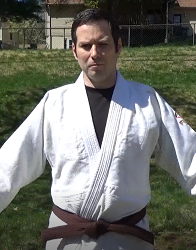Fundamentals: the gi
Understanding the proper way to wear the gi and its parts.
Continue reading
Gedan Barai
Gedan barai protects your midsection from attack, but it's crucial to understand the fundamentals of this technique.
Continue reading
Ukemi - The art of 'getting back up'
Falling is not a question of 'if', but 'when'. Knowing how to fall helps ensure that you will be able to get back up.
Ukemi
Ukemi, in its simplest definition, is the “act of receiving”, or more specifically the act of receiving oneself. It is through the forms and techniques of ukemi that one is able to fall or be thrown with great force and still get back up without significant injury.
As you study ukemi throughout your martial arts journey you will begin to understand the personal implications. The phrase “just roll with it” accurately describes the concepts of ukemi, demonstrating how the dynamics of resistance and submission result in a state of wholeness and balance at the end of every action.
Ushiro Ukemi
Ushiro ukemi is to receive a fall toward your back. In all ukemi techniques it is of utmost importance to protect the neck and head. In ushiro ukemi, tilt the chin so that it is touching or close to touching the chest. This allows the back of the head to avoid impact which can cause severe injury or death.
Allow yourself to fall on your glutes. Since the shape of the back is naturally round, allow the momentum of the fall to carry you backward in a rolling motion. Fully extend the arms down to your side at about 30° with the palms down to stop the roll before the upper third of the back has received the fall to stop the momentum.
Yoko Ukemi
Yoko ukemi is to receive a fall toward your side. Protect the head by tilting the chin toward the shoulder to the opposite side of the fall. Allow the leg to receive the fall at the thigh and hip. Impact the ground with the arm on the side that you are falling to fully extended at about 30° to the body with the hand toward your feet and your palm down. Allow the momentum to carry to the outside of the shoulder.
Mae Ukemi
Mae ukemi is to receive a fall forward. Keep the upper body straight and tense. Start the fall with the palms facing in, and transition the hands so that the palms are to the ground at impact. The hands should be at about the same level as the ears.
The forearms and hands should receive the impact together. Receiving the impact on the hands and wrists can cause injury.
Just prior to impacting the arms, turn the head to the side to avoid impacting the face with the ground.